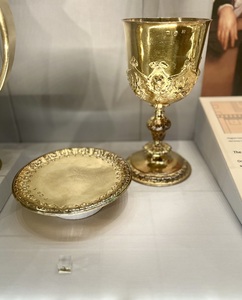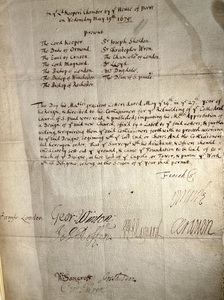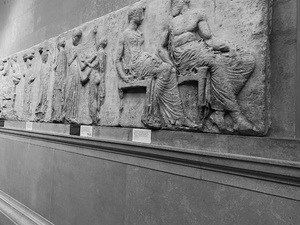
Browse Items (226 total)
Sort by:
-
South Sea Whale Fishery
A colored aquatint depicting 19th century British whaling vessels hunting sperm whales off the island of Buru -
Bark Charles W. Morgan under sail
A photograph taken in 1920 of the Charles W. Morgan under sail -
Photo of The Palmerstone Gold Chocolate Cups
This is a photo of The Palmertstone Gold Chocolate Cups. This photo was taken during the UAH Study Abroad to London. These cups are located at the British Museum. These cups were created by John Cartier in 1700. -
Paten and Chalice.
This paten and chalice were created for St. James Picadilly in 1683. It was designed to complement Sir Christopher Wren's, the architect of the church, rich interior. -
Legal document on the rebuilding of St. Paul's Cathedral.
After the Great Fire of 1666, St Paul's Cathedral needed to be rebuilt after being destroyed. This document marks the beginning of the rebuilding with the laying of the foundation. The document is signed by many notable people of the time, including Sir Christopher Wren who was tasked with the rebuilding of 51 city churches after the Great Fire. -
Cadbury Chocolate for Sale at Tesco Express
Photo of Cadbury Chocolate for sake at Tesco Express. This shows that Cadbury is a relevant company. Sir Sloane's chocolate milk inspired the Cadbury brothers. -
Bust of Sir Hans Sloane in the British Library
This is a photo of the Bust of Sir Hans Sloane in the British Library. This is a replica of Sir Sloane's bust in the British Museum by Rysbrack. This bust is in the library because of Sir Sloane's contributions to the library. -
Entrance to the British Library
This is the entrance to the British Library. It says British Library over and over. The British Libary was founded partially by Sir Sloane's collection. -
Alternate Entrance to The British Museum
This is a side entrance to the British Museum. The bust of Sir Hans Sloane and the Palmerstone Gold Cups are located here. This museum houses much of Sir Sloane's collections. -
Frieze from the Parthenon
The British Museum currently has 247 feet (75 m.) of the original Parthenon frieze within their permanent collection. The frieze was the sculpted high-relief, which adorned the upper part, or naos of the Parthenon. In the exhibit space, each section of the frieze has a placard, which describes the scene depicted on the section of frieze as well as the cardinal direction and number in the frieze series. The marble frieze, which dates c. 438- 432 BC, depicts a Panathenaic procession.









